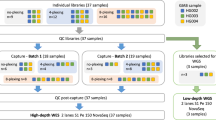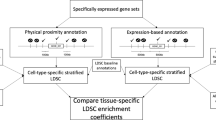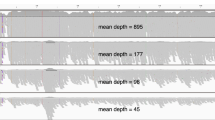Abstract
Whole-exome sequencing (WES) has become the strategy of choice to identify causal variants in monogenic disorders. However, the list of candidate variants can be quite large, including false positives generated by sequencing errors. To reduce this list of candidate variants to the most relevant ones, a cost-effective strategy would be to focus on regions of linkage identified through linkage analysis conducted with common polymorphisms present in WES data. However, the non-uniform exon coverage of the genome and the lack of knowledge on the power of this strategy have largely precluded its use so far. To compare the performance of linkage analysis conducted with WES and SNP chip data in different situations, we performed simulations on two pedigree structures with, respectively, a dominant and a recessive trait segregating. We found that the performance of the two sets of markers at excluding regions of the genome were very similar, and there was no real gain at using SNP chip data compared with using the common SNPs extracted from WES data. When analyzing the real WES data available for these two pedigrees, we found that the linkage information derived from the WES common polymorphisms was able to reduce by half the list of candidate variants identified by a simple filtering approach. Conducting linkage analysis with WES data available on pedigrees and excluding among the candidate variants those that fall in excluded linkage regions is thus a powerful and cost-effective strategy to reduce the number of false-positive candidate variants.
Similar content being viewed by others
Log in or create a free account to read this content
Gain free access to this article, as well as selected content from this journal and more on nature.com
or
References
1000 Genomes Project Consortium: An integrated map of genetic variation from 1,092 human genomes. Nature 2012; 491: 56–65.
Ng SB, Buckingham KJ, Lee C et al: Exome sequencing identifies the cause of a mendelian disorder. Nat Genet 2010; 42: 30–35.
Browning BL, Browning SR : Detecting identity by descent and estimating genotype error rates in sequence data. Am J Hum Genet 2013; 93: 840–851.
Li H, Homer N : A survey of sequence alignment algorithms for next-generation sequencing. Brief Bioinform 2010; 11: 473–483.
Lander ES, Botstein D : Homozygosity mapping: a way to map human recessive traits with the DNA of inbred children. Science 1987; 236: 1567–1570.
Lander ES, Green P : Construction of multilocus genetic linkage maps in humans. Proc Natl Acad Sci USA 1987; 84: 2363–2367.
1000 Genomes Project Consortium: A map of human genome variation from population-scale sequencing. Nature 2010; 467: 1061–1073.
Delaneau O, Zagury J-F, Marchini J : Improved whole-chromosome phasing for disease and population genetic studies. Nat Methods 2013; 10: 5–6.
Abecasis GR, Cherny SS, Cookson WO, Cardon LR : Merlin—rapid analysis of dense genetic maps using sparse gene flow trees. Nat Genet 2002; 30: 97–101.
Morton NE : Sequential tests for the detection of linkage. Am J Hum Genet 1955; 7: 277–318.
Gazal S, Sahbatou M, Babron M-C, Génin E, Leutenegger A-L : FSuite: exploiting inbreeding in dense SNP chip and exome data. Bioinformatics 2014; 30: 1940–1941.
Hervé D, Philippi A, Belbouab R et al: Loss of α1β1 soluble guanylate cyclase, the major nitric oxide receptor, leads to moyamoya and achalasia. Am J Hum Genet 2014; 94: 385–394.
Rüschendorf F, Nürnberg P : ALOHOMORA: a tool for linkage analysis using 10 K SNP array data. Bioinformatics 2005; 21: 2123–2125.
Sanger F, Nicklen S, Coulson AR : DNA sequencing with chain-terminating inhibitors. Proc Natl Acad Sci USA 1977; 74: 5463–5467.
Huang Q, Shete S, Amos CI : Ignoring linkage disequilibrium among tightly linked markers induces false-positive evidence of linkage for affected sib pair analysis. Am J Hum Genet 2004; 75: 1106–1112.
Boyles AL, Scott WK, Martin ER et al: Linkage disequilibrium inflates type I error rates in multipoint linkage analysis when parental genotypes are missing. Hum Hered 2005; 59: 220–227.
Goode EL, Badzioch MD, Jarvik GP : Bias of allele-sharing linkage statistics in the presence of intermarker linkage disequilibrium. BMC Genet 2005; 6 (Suppl 1): S82.
Levinson DF, Holmans P : The effect of linkage disequilibrium on linkage analysis of incomplete pedigrees. BMC Genet 2005; 6 (Suppl 1): S6.
Cho K, Yang Q, Dupuis J : Handling linkage disequilibrium in linkage analysis using dense single-nucleotide polymorphisms. BMC Proc 2007; 1 (Suppl 1): S161.
Bellenguez C, Ober C, Bourgain C : Linkage analysis with dense SNP maps in isolated populations. Hum Hered 2009; 68: 87–97.
Abecasis GR, Wigginton JE : Handling marker-marker linkage disequilibrium: pedigree analysis with clustered markers. Am J Hum Genet 2005; 77: 754–767.
Ott J, Wang J, Leal SM : Genetic linkage analysis in the age of whole-genome sequencing. Nat Rev Genet 2015; 16: 275–284.
Wang GT, Zhang D, Li B, Dai H, Leal SM : Collapsed haplotype pattern method for linkage analysis of next-generation sequence data. Eur J Hum Genet 2015, ; e-pub ahead of print 15 April 2015; doi:10.1038/ejhg.2015.64.
Norton N, Li D, Rampersaud E et al: Exome sequencing and genome-wide linkage analysis in 17 families illustrate the complex contribution of TTN truncating variants to dilated cardiomyopathy. Circ Cardiovasc Genet 2013; 6: 144–153.
Krawitz PM, Schweiger MR, Rödelsperger C et al: Identity-by-descent filtering of exome sequence data identifies PIGV mutations in hyperphosphatasia mental retardation syndrome. Nat Genet 2010; 42: 827–829.
Guergueltcheva V, Azmanov DN, Angelicheva D et al: Autosomal-recessive congenital cerebellar ataxia is caused by mutations in metabotropic glutamate receptor 1. Am J Hum Genet 2012; 91: 553–564.
Eggers S, Smith KR, Bahlo M et al: Whole exome sequencing combined with linkage analysis identifies a novel 3 bp deletion in NR5A1. Eur J Hum Genet 2014; 23: 486–493.
Smith KR, Bromhead CJ, Hildebrand MS et al: Reducing the exome search space for Mendelian diseases using genetic linkage analysis of exome genotypes. Genome Biol 2011; 12: R85.
Acknowledgements
We thank Emmanuelle Génin for her very helpful comments. E Verdura was supported by Programme Hospitalier de Recherche Clinique AOM06037 (grant to ET-L). S Guey was a recipient of a fellowship from the Fondation pour la Recherche Médicale.
Author information
Authors and Affiliations
Corresponding author
Ethics declarations
Competing interests
The authors declare no conflict of interest.
Additional information
Supplementary Information accompanies this paper on European Journal of Human Genetics website
Supplementary information
Rights and permissions
About this article
Cite this article
Gazal, S., Gosset, S., Verdura, E. et al. Can whole-exome sequencing data be used for linkage analysis?. Eur J Hum Genet 24, 581–586 (2016). https://doi.org/10.1038/ejhg.2015.143
Received:
Revised:
Accepted:
Published:
Issue date:
DOI: https://doi.org/10.1038/ejhg.2015.143
This article is cited by
-
Variable expressivity and genetic heterogeneity involving DPT and SEMA3D genes in autosomal dominant familial Meniere’s disease
European Journal of Human Genetics (2017)



